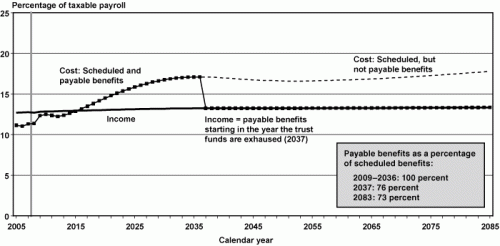It is likely you have been paying social security taxes for a large portion of your life. It is also likely you haven’t received any benefits because, even though social security benefits cover about 62 million people, only the elderly, disabled workers, and families with a deceased parent or spouse are covered. The program has become more expensive over time – the social security amount at the end of the period (receipts, expenditures, and net increases in Trust Funds) has increased approximately 22,000 percent from 1937 to 2009. As of last year, social security debt was nearly $2.9 trillion. There is a major problem with the future of the program – if you are younger than 50, you will likely never receive the current social security benefits since the program is projected to run out of money by 2034. However, if political challenges can be resolved, the life of social security can be extended well beyond 2034 by implementing lower benefits and higher taxes. The bottom line is simple – If overall benefits are not lowered and taxes are not raised, you will not receive social security benefits beyond 2034.
Who Contributes?
Most of the population gains from social security benefits, but the majority of direct benefits are distributed to elderly Americans at age 67, disabled workers, and families with a deceased parent or spouse. Approximately 62 million people make up these groups, while the majority of American taxpayers, 173 million people, contribute to social security. Employees in the workforce are not the only ones paying for social security – by law, employers are also required to match the social security taxes for each employee. With the given employer contributions, each employee amounts to a 12.4 percent tax rate for social security. Aside from civilian payment for social security, the government’s payment for the program is fairly high. In 2016, 24 percent of the federal government’s GDP budget spending, or $916 billion, was proctored to social security.
Main Problem: Cost
The primary issue with social security is cost. The most prominent options for maintaining current funding levels for the program are both to significantly cut benefits and raise taxes. Both tasks are politically challenging since the elderly are highly protective of their current benefits and the overall population opposes most tax increases. But change is necessary if social security is to stay afloat. If nothing is done, there will be about a 25 percent cut in benefits during 2034, as projected by AARP. The Social Security Agency argues differently.

Based on 2009-2010 projections, they believe social security can pay full benefits until 2036 and, in 2037, will be capable of paying 76 percent of benefits. According to their projections, 2037 is when the trust funds will be exhausted. Even if the Social Security Agency’s projections are correct, having two more years to pay full benefits is insignificant if changes are not made.
In the past, government plans for lowering national debt have included lowering social security benefits and increasing taxes. Specifically, a 2010 bipartisan report called the Simpson-Bowles Plan provided new recommendations to keep social security solvent, such as cutting overall benefits for higher income households, increasing the normal retirement age to 69, and requiring social security taxes on the first 90 percent of income up to $190,000. Even though the plan was projected to save about $3.8 trillion through 2020, it was never implemented after being politically defeated multiple times.
Solutions
Influenced by the Simpson-Bowles Plan, an important potential solution to social security exists – implement a lower benefit cap and remove the tax cap. According to research, capping the maximum annual benefit amount at $35,000 is an appropriate figure. The cap would eventually be reached by all income groups and result in a flat benefit payout at all income levels. Removing the tax cap would primarily affect workers surpassing the cap, which are only about 6 percent of the population, according to 2016 statistics. However, the 6 percent are economically significant since data shows removing the tax cap is estimated to fill 86 percent of the social security funding gap.
Adding a benefit cap and removing the tax cap would be economically beneficial but politically challenging. A prominent political barrier exists in the Executive Branch, where a few issues arise – President Trump is against cutting social security benefits and doesn’t want to increase taxes. Trump’s views on cutting benefits and increasing taxes arise from his desire to appear popular to voters. It is very unlikely Trump will leverage for implementing a social security benefit cap or removing the tax cap – both tasks would be initially unpopular. As a result, social security might be required to wait until 2021 or longer to experience prominent changes.
Conclusion
Solutions exist to solving the $2.9 trillion social security debt. By adding a benefit cap and removing the social security tax cap, the debt would be eliminated over time. However, due to the fact that President Trump needs to appear politically attractive to voters, he will refrain from capping benefits or increasing taxes. Implementing these changes would prevent social security from running out of money by 2034. Instead, the future of social security is unsure as it lies in the hands of an individual appealing to political assurance. To save social security, President Trump needs to act economically inclined instead of politically insecure.
Featured Image Source: Huffington Post






Be First to Comment